OSAMA BIN LADEN AFTER THE AMERICAN INVASION OF AFGHANISTAN
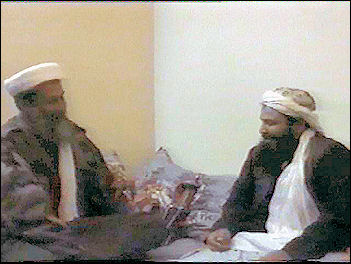
Osama bin Laden three months
after September 11 After the fall of Kandahar and the end of the Taliban government, the Afghanistan conflict became less of war and more of a man hunt for Osama bin Laden and the leaders of Al-Qaida. Paul Haven of AP wrote: “As the Taliban quickly fell under pressure of the US bombardment, bin Laden fled into the inhospitable mountains in the seam that separates Pakistan and Afghanistan, keeping up a spotty stream of chatter - first in video tapes and then in scratchy audio recordings - to warn his Western pursuers of more bloodshed. [Source: Paul Haven, AP, May 2, 2011]
Just hours after the US assault on Afghanistan began on October 7, 2001, bin Laden appeared in a video delivered to Al-Jazeera, an Arab satellite television station, to issue a threat to America. "I swear by God ... neither America nor the people who live in it will dream of security before we live it in Palestine, and not before all the infidel armies leave the land of Muhammad, peace be upon him," said bin Laden, dressed in fatigues. He reappeared in a video appearance broadcast by Al-Jazeera on December 27, 2001, shortly after US forces apparently had him cornered in Tora Bora.
Ahmed Rashid, the respected author of “The Taliban,” wrote in the Washington Post: “It was in eastern Afghanistan that bin Laden made his last public appearance in Jalalabad on Nov. 10, 2001, just after the northern cities had begun to fall to the anti-Taliban alliance. He addressed an estimated 1,000 Pashtun notables and militants, urging them to continue resisting the American invaders, according to U.S. journalists working in the region at the time. He dished out wads of U.S. and Pakistani cash and then disappeared into the mountain fastness of Tora Bora, never to be seen again. (The CIA didn't learn of the meeting for several days.) [Source: Ahmed Rashid, Washington Post, March 1, 2006]
Tora Bora

Tora Bora Tora Bora is a giant cave complex in eastern Afghanistan, near the Pakistan border, southwest of Jalalabad. In the mid 1990s bin Laden built a two-bedroom cave hideout there that had a crude swimming pool. In 2001, bin Laden and top Al-Qaida leaders are believed to have holed themselves up in Tora Bora after they fled from Kandahar during the American invasion of Afghanistan. Hundreds of al-Qaida suspects are believed to have escaped the massive US bombing campaign there. Tora Bora itself became the site of heavy bombing raids, and an intensive search for bin Laden and top Al-Qaida leaders.
Located among the 13,000-foot-high peaks of the Spin Ghar Range, Tora Nora served as a mujahidin base during the war against the Soviets in the 1980s, when mujahidin survived repeated Soviet bombing raids and three offensives to capture it. It was regarded as the mujahidin’s best defended stronghold and Osama bin Laden may have helped to build it. Tora Bora means “Black Dust” in Pashto.
The whole Tora Bora area is honeycombed with caves and tunnels. At the time of the American invasion of Afghanistan some caves had ventilation shafts, lights and generators and escape tunnels that went from one side of a mountain to the another. The largest tunnels were eight-foot wide and carved 1,150 feet deep into the mountain. Some caves were believed to be defended by machine nests and ant-aircraft guns mounted behind barricades made from metal salvaged from Soviet tanks. Positioned on steep slopes, the caves were all but invisible from the sky and the narrow valley below.
The region around Tora Bora has traditionally been known for lawlessness. Al-Qaida thrived on this kind of environment. Villagers and warlords in the area were considered to be sympathetic to the Al-Qaida and Taliban cause. They had a long history of distrusting foreigners, plus they were not pleased when some of their people will killed in American bombing raids.
Osama bin Laden, Al-Qaida and the Tora Bora Caves
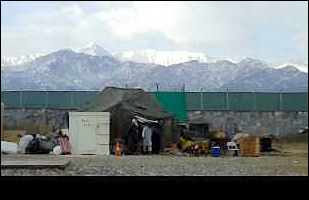
Tora Bora village Peter Bergen wrote in Vanity Fair: “According to a widely reported background briefing by Pentagon officials in mid-December 2001, there was “reasonable certainty” that bin Laden was indeed at Tora Bora, a judgment based on intercepted radio transmissions. General Franks himself recounted in his autobiography, “American Soldier,” that in December 2001 he briefed President Bush, saying, “Unconfirmed reports have it that Osama has been seen in the White Mountains, Sir. The Tora Bora area.” In June 2003, I met with several senior U.S. counterterrorism officials, who explained, “We are confident that [bin Laden] was at Tora Bora and disappeared with a small group.” [Source: Peter Bergen, Vanity Fair, January 2006]
Locals in the village of Wazir near Tora Bora insisted that Osama bin Laden had arrived in the Tora Bora region around October 1 with one of his sons in convoy of vehicles accompanied by 1,000 Al-Qaida fighters. The “Arabs” that accompanied him rented houses in the area and paid villagers to truck in food. When the Allied forces got near they headed for the caves.
Abdellah Tabarak, bin Laden’s Moroccan bodyguard: Following the U.S. bombing of Afghanistan, I left Kandahar in the company of bin Laden, Ayman al-Zawahiri, and a number of guards. During the month of Ramadan in the same year, we entered Tora Bora, where we stayed for 20 days. From there Ayman al-Zawahiri fled, accompanied by Uthman, the son of Osama bin Laden. [Source: Peter Bergen, Vanity Fair, January 2006]

Inside Tora Bora cave Al-Qaida hid out in natural caves, old caves, karez irrigation tunnels, mining caves, and a broad network caves built by the mujahidin during the Soviet occupation to use as hideouts and attack bases. Some of the caves had sleeping mats on the floors and were heated with stoves that emitted very little smoke. Some of these had entrances concealed with camouflage and booby-trapped with mines. Others had special rooms and ammunition storage areas in tunnels set at right angles for protection from bombs. Food was stored outside and cooking and washing was also done outside.
Osama bin Laden is believed to have lived in a sophisticated cave with entrances large enough to accommodate supply vehicles and tanks. This cave had electricity provided by generators, a command center, storage for tanks and heavy weapons, rooms for sleeping, hanging out and praying and several escape exits. David Remnick wrote in The New Yorker: “Bin Laden signed his last will and testament on December 14, 2001, while hiding in the caves of Tora Bora, instructing his children not to work for Al Qaeda: “If it is good, then we have had our share; if it is bad, then it is enough.” [Source: David Remnick, The New Yorker, May 16, 2011]
American Operation at Tora-Bora

Strikes on Tora Bora The United States began bombing Tora Bora on December 3. The operation consisted primarily of bombing the hell out of selected targets and then checking them on foot later. Surveillance planes, Predator drones, satellites and information from local people was used to locate caves that might be used by Al-Qaida and Taliban fighters.
Satellites are not very effective in locating individuals or small groups. Surveillance planes and drones scanned for vehicle tracks, well-worn foot paths, camp fires and generator exhaust. These provided clues as to which caves Al-Qaida were hiding out in. Reconnaissance planes were equipped with infrared heat-detecting sensors and infrared cameras that could spot tactical targets such small groups siting around a camp fire near a cave. The cameras provided real-time imagery in a televison format.
F-18s and helicopter with infrared equipment were use to located targets with people in them. Then F-18s ad f-15s were called to deliver the bombs. Ground troops, mostly local Afghans, conducted cave to cave searches. They were paid about $200 a month. Many of these men were regarded as traitors by local villagers. Some who died were not given burial prayers by local mullahs.
A whole arsenal of weapons specially designed to penetrate the cave hideouts of Al-Qaida and Taliban fighters was deployed. These included the GBU-28 Bunkerbuster, a 5000-pound laser-guided bomb designed to collapse caves. This weapon can penetrate 30 feet or more into the ground (or 20 feet of concrete) before exploding. The AGM-130 precision-guided missile is designed to enter caves and explode inside. Cave inhabitants are killed by “overpressure” which causes their lungs to explode. The AGM-65 Maverick seeks out targets using heat-seeking technology.

SEALs at_Zhawar Kili cave entrance AGMs were sent into cave entrances and dropped down cave ventilation shafts. GBU-28s were fired into mountain sides above the caves. BLU-82 daisy cutters were exploded front of cave entrances. The intense pressure produced by these bombs destroyed everything inside the cave. A BLU-1186 — small version of the BLU-82, a fuel-air explosive with highly flammable chemicals — killed by sucking out all the oxygen in the caves.
Many argued that the best way to attack the caves was to seal them with explosives and bulldozers rather then enter them and risk being ambushed or booby trapped. If a cave was entered the basic strategy was first to cripple the cave occupants with tear gas or fuel-air explosives that suck all the oxygen out of the air, then carefully check for mines and booby traps. After entering a cave soldiers preferred to use single shot weapons, flame throwers, knives and night vison equipment. They moved in the dark, stayed close to members of their unit, and avoided grenades and automatic weapons which can produce blowback and ricocheting bullets.
On December 6, anti-Taliban forces captured the main base used by Osama bin Laden at Tora Bora but failed to find him. They did find caches of weapons, tanks, expensive communication equipment, terrorist training facilities, unrefined opium, Pakistani passports with work visas and a child’s foot still in a shoe.. On December 16, Tora Bora fell. After three weeks the operation was largely over.
Osama bin Laden Survives the Bombing of Tora Bora

Zhawar Kili Cave Complex, Pre-strike Abu Jaafar al-Kuwaiti, an eyewitness of the Tora Bora bombing, posted the following account on al-Qaeda’s main website in 2002: “November 14, 2001. Mujahid Sheikh Osama bin Laden and his special group arrived to the area 9,000 feet above sea level in the Tora Bora mountains with its extreme terrain and cold weather. We were with him. This position had more than 15 trenches to protect the mujahideen from the insane American strikes that started five days before. The trenches were built by our hands and effort and by our brothers, the Afghan mujahideen. Then we witnessed the increase in flights of [U.S. Predator drones] that did not leave the area night or day. [Source: Peter Bergen, Vanity Fair, January 2006]
On December 9 “at a late hour of the night, we were awakened to the sound of massive and terrorizing explosions very near to us. It was the place where the trench of Sheikh Osama bin Laden was. The night was very long and very worrisome [as we waited] for what the morning would bring [to] see what this barbaric raid had done.” In the morning — we received the horrifying news! The trench of Sheikh Osama had been destroyed; the trench where Sheikh used to come out every day to check the mujahideen situation and follow the news of the battle. [But] God kept Osama bin Laden alive, because he left the bunker only two nights [before] to an area only 200 meters away.
On an audiotape that aired on Al Jazeera on February 11, 2003 Osama bin Laden said: “Now, I am going to tell you a part of that great battle [of Tora Bora] so that I [will] prove to you how cowardly [the Americans] are. We were only 300 fighters. We had already dug 100 trenches, spread out in a space that didn’t exceed one square mile. On the morning of the 17th of Ramadan [December 3, 2001], very heavy bombing started, especially after the American leadership made sure that some of the leadership of al-Qaeda were in Tora Bora, including myself and the mujahid brother Dr. Ayman al-Zawahiri. The bombing became around the clock. Not a second would pass without a fighter plane passing over our heads day and night. American forces were bombing us by smart bombs that weigh thousands of pounds and bombs that penetrate caves.
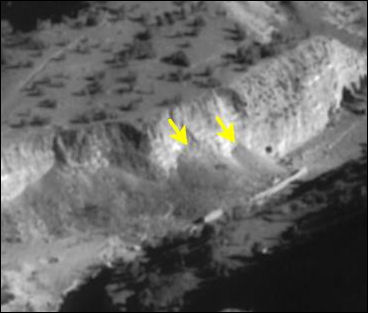
Zhawar Kili Cave Complex, Post-strike [That was] in addition to the forces [of the Northern Alliance], whom they pushed to attack us for a continuous month. We fought back against all their attacks. And we defeated them every time. In spite of all that, American forces did not dare to go into our posts. What sign is more than that for their cowardice? With all its forces that were fighting against a small group of 300 mujahideen in the trenches, inside one square mile, in minus 10 degrees of temperature. The result of the battle was that we lost 6 percent of our force [18 men].
The advantages that the Al-Qaida and Taliban fighters had at Tora Bora were that were highly mobile, they knew the terrain and they had support from the local population. Abdel Bari Atwan, who interviewed bin Laden at Tora Bora in 1996, said: I wasn’t surprised [that Osama was in Tora Bora in 2001]. I expected him to be there. I was in the Gulf region, and I met somebody from al-Qaeda, and he told me that Osama bin Laden was injured during the Tora Bora bombing, and he was operated on his left shoulder. And then when I saw his first videotape, immediately after Tora Bora, I said something is wrong with his left shoulder. His left shoulder was very stiff, and he couldn’t move his left hand. And many people from al-Qaeda actually were extremely furious I said that [publicly], because they don’t want him to be reported as injured.
Osama bin Laden’s Escape from Tora Bora
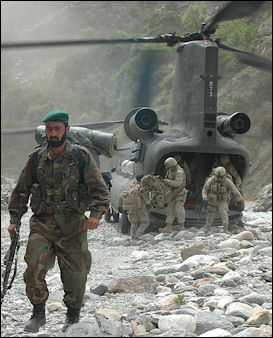
Afghan and American soldiers
in Tora Bora Many analysts believe that Osama bin Laden was in Tora Bora when searches of the area began. It is widely believed that he escaped across the border into the frontier regions of Pakistan. There were reports that he had been spotted in Wazirstan, a tribal area of Pakistan. According to a German spy agency bin Laden bribed Afghan militias to give him free passage.
On December 7th, soldiers said they heard Osama bin Laden on the radio. He said he was still in the area but “they were getting ready to move.” The next morning tribesmen said they saw him heading for the Pakistan border on horseback with four Al-Qaida guards. The tribesmen then said they lost him, caught sight of him again and lost him again.
Abdellah Tabarak, bin Laden’s Moroccan bodyguard, said: After the bombing “bin Laden fled with his son Muhammad, accompanied by Afghan guards, while I fled with a group made up mainly of Yemenis and Saudis in the direction of Pakistan. We were arrested by the Pakistani authorities at a border checkpoint, and they handed us over to the U.S. authorities, who deported us to the Guantánamo detention camp, in Cuba. [Source: Peter Bergen, Vanity Fair, January 2006] Tabarak said he helped bin Laden escape by taking bin Laden’s satellite phone and heading one direction and making calls with it while Osama bin Laden and the other Al-Qaida leaders headed in a different direction. It is believed that Osama bin Laden moved several times on horseback on cloudy nights to avoid detection by satellites.
The best estimates are that bin Laden either walked, rode a donkey, or took a bus across the border into Pakistan, sometime in the third week of December, 2001. Terrorism expert Richard Clarke told the The New Yorker he thought the United States had waited too long before starting to bomb Tora Bora, and the U.S. operation relied too heavily on “Afghans it had rented.” Tora Bora was the last place that bin Laden was definitively detected alive by the United States.
Second Guessing the Tora Bora Effort

Tora Bora meeting U.S. forces had their best chance to catch Osama bin Laden at Tora Bora. John-Thor Dahlburg and Alex Rodriguez wrote in the Los Angeles Times: The U.S. military's decision not to send U.S. Special Forces into Tora Bora was ill-fated.U.S. Gen. Tommy Franks, head of the operation in Afghanistan, gave the job of flushing out Bin Laden to a ragtag band of Afghan fighters, a move that most analysts say gave Bin Laden and his aides the opportunity to flee to Pakistan. [Source: John-Thor Dahlburg and Alex Rodriguez, Los Angeles Times May 2, 2011]
Many analysts believe that the decision to rely local Afghan fighters to conduct the searches may have cost the United States its best chance of catching bin Laden. That decision was made primarily because the local people new the terrain better, could more easily distinguish friend from foe, and there were concerns about American causalities. Some believe these locals were also susceptible to bribes and had loyalties to Al-Qaida and the Taliban and may have actually helped Osama bin Laden escape.
Others believe the Americans should have entrusted local fighters more. These people believe that the local Afghans could done a better job if the American had equipped them better, assisted them in doing their job their way and didn’t scare everybody off by dropping bombs all over the place. Most analysts now believe that the best strategy would have been to slowly surround Osama bin Laden, using large numbers of American troops, and pay careful attention to make sure all the escape routes are sealed off. And slowly move in on him.
Peter Bergen wrote in Vanity Fair: Why did the U.S. military not seal off the Tora Bora region, instead relying only on a handful of Special Forces on the ground? Part of the answer is that the U.S. military was a victim of its own success. Scores of Special Forces calling in air strikes, in combination with thousands of Afghans on the ground, destroyed the Taliban army in a few weeks of fighting. However, this approach was a failure at Tora Bora, where large numbers of Americans on the ground were needed to throw up an effective cordon around al-Qaeda’s leaders. Apologists for the U.S. military failure at Tora Bora will no doubt provide some compelling reasons why this was the case, including a lack of airlift capabilities from the former U.S. air base known as K2, in neighboring Uzbekistan. However, such explanations are hard to square with the fact that scores of journalists managed to find their way to Tora Bora, a battle covered on live television by the world’s leading news organizations. Sadly, there were more American journalists on the ground at the battle of Tora Bora than there were U.S. soldiers. The battle was a missed opportunity to bring bin Laden to justice. [Source: Peter Bergen, Vanity Fair, January 2006]
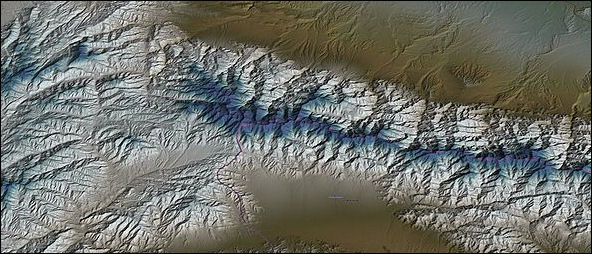
Tora Bora mountains with Pakistan a short distance away
“The question of whether the United States missed an opportunity to capture or kill bin Laden during the battle of Tora Bora became an issue in the razor-close 2004 U.S. presidential campaign,” Bergen wrote. During the September 30, 2004, presidential debate, the Democratic contender, Senator John Kerry, said, “He escaped in the mountains of Tora Bora. We had him surrounded.” Writing in The New York Times a little more than two weeks later, General Tommy Franks, a Bush supporter and the overall commander of the Tora Bora operation, wrote, “We don’t know to this day whether Mr. bin Laden was at Tora Bora.” At a town-hall meeting in Ohio around the same time, Vice President Cheney said Kerry’s critique of the Tora Bora campaign was “absolute garbage.” President Bush himself weighed in on the question of bin Laden’s Tora Bora presence, or lack thereof, at a campaign rally a week before the election, saying: “[It’s part of Kerry’s] pattern of saying anything it takes to get elected. Like when he charged that our military failed to get Osama bin Laden at Tora Bora, even though our top military commander, General Tommy Franks, said, “The senator’s understanding of events does not square with reality,” and intelligence reports place bin Laden in any of several different countries at the time.”
Image Sources: Wikimedia Commons
Text Sources: New York Times, Washington Post, Los Angeles Times, Times of London, The Guardian, National Geographic, The New Yorker, Time, Newsweek, Reuters, AP, AFP, Wall Street Journal, The Atlantic Monthly, The Economist, Global Viewpoint (Christian Science Monitor), Foreign Policy, Wikipedia, BBC, CNN, NBC News, Fox News and various books and other publications.
Last updated July 2012
